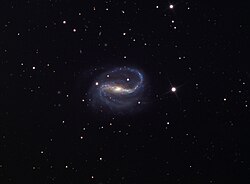NGC 7479
| NGC 7479 | |
|---|---|
 | |
| Pozorovací údaje (Ekvinokcium J2000,0) | |
| Typ | spirální galaxie s příčkou SB(s)c[1] |
| Objevitel | William Herschel[2] |
| Datum objevu | 1784[2] |
| Rektascenze | 23h 04m 56,6s[1] |
| Deklinace | +12°19′22″[1] |
| Souhvězdí | Pegas |
| Zdánlivá magnituda (V) | 11[2] |
| Úhlová velikost | 4,1' x 3,1'[1] |
| Vzdálenost | 112,3 ± 9,7 Mly (34,4 ± 3,0 Mpc)[1] |
| Plošná jasnost | 13,6[2] |
| Rudý posuv | 2 381 km/s[1] |
| Označení v katalozích | |
| New General Catalogue | NGC 7479 |
| IRAS | IRAS F23024+1204, IRAS 2302+120P15, IRAS F23024+1203 a IRAS 23024+1203 |
| Uppsala General Catalogue | UGC 12343 |
| Principal Galaxies Catalogue | PGC 70419 |
| Jiná označení | UGC 12343, PGC 70419[1] Caldwell 44 |
| (V) – měření provedena ve viditelném světle | |
| Některá data mohou pocházet z datové položky. | |
NGC 7479 (také známá jako Caldwell 44) je spirální galaxie s příčkou v souhvězdí Pegase vzdálená přibližně 112 milionů světelných let. Objevil ji britský astronom William Herschel v roce 1784. Na obloze se nachází ve vzdálenosti 3 stupňů směrem na jih od hvězdy Markab (α Peg) s magnitudou 2,5.
NGC 7479 se řadí mezi Seyfertovy galaxie a obsahuje oblast slabě ionizovaného plynu (low ionization nuclear emission region - LINER), ve které dochází k prudké tvorbě hvězd, a to nejenom v jádře a vnějších ramenech, ale i v galaktické příčce, kde většina hvězd vznikla v minulých 100 milionech let.[3] Podrobný výzkum této galaxie ukázal, že nedávno pohltila jinou malou galaxii, a že vypadá zvláštně v oblasti rádiových vln, kde se její ramena odvíjejí na opačnou stranu než v oblasti viditelného záření.[4] Toto je možné vysvětlit, spolu s nesymetrií ramen a prudkou tvorbou hvězd, právě pohlcením malé galaxie.[3] Svou velikostí a tvarem se podobá známé spirální galaxii s příčkou NGC 1300.
Supernovy
V roce 1990 zde byla nalezena supernova typu Ic s názvem SN 1990U, která v maximu dosáhla magnitudy 16, a v roce 2009 další typu Ib s názvem SN 2009jf a maximem 18 mag.[5]
Galerie obrázků
- NGC 7479 na snímku z amatérského dalekohledu.
- NGC 7479 na snímku z 24-palcového dalekohledu Schulman Foundation na hoře Mt. Lemmon v Arizoně (USA).
Reference
V tomto článku byl použit překlad textu z článku NGC 7479 na anglické Wikipedii.
- ↑ a b c d e f g NASA/IPAC Extragalactic Database: Results for NGC 7479 [online]. [cit. 2016-09-09]. Dostupné online. (anglicky)
- ↑ a b c d The NGC/IC Project: Results for NGC 7479 [online]. [cit. 2016-09-09]. Dostupné v archivu pořízeném dne 2009-05-28. (anglicky)
- ↑ a b ZHOU, Zhi-Min; CAO, Chen; MENG, Xian-Min, et al. Star formation properties in barred galaxies (SFB). I. Ultraviolet to infrared imaging and spectroscopic studies of NGC 7479. S. 38. Astronomical Journal [online]. Srpen 2011 [cit. 2016-09-09]. Roč. 142, čís. 2, s. 38. Dostupné online. DOI 10.1088/0004-6256/142/2/38. Bibcode 2011AJ....142...38Z. (anglicky)
- ↑ LAINE, Seppo; BECK, Rainer. Radio Continuum Jet in NGC 7479. S. 128–142. Astrophysical Journal [online]. 2008-01-20 [cit. 2016-09-09]. Roč. 673, čís. 1, s. 128–142. Dostupné online. DOI 10.1086/523960. Bibcode 2008ApJ...673..128L. (anglicky)
- ↑ List of Supernovae [online]. Harvard-Smithsonian Center for Astrophysics (IAU) [cit. 2016-09-09]. Dostupné online. (anglicky)
Externí odkazy
 Obrázky, zvuky či videa k tématu NGC 7479 na Wikimedia Commons
Obrázky, zvuky či videa k tématu NGC 7479 na Wikimedia Commons - Simbad – NGC 7479
- NED – NGC 7479
Média použitá na této stránce
Autor: NASA Hubble, Licence: CC BY 2.0
In this Hubble image of Caldwell 44, also known as NGC 7479, the tightly wound arms of the barred spiral galaxy create a backward "S" as they spin in a counter-clockwise direction. However, this galaxy, nicknamed the Propeller galaxy, emits a jet of radiation in radio wavelengths that bends in the opposite direction to the stars and dust in the arms of the galaxy. Astronomers think that the radio jet was put into its bizarre backward spin after the Propeller galaxy merged with another galaxy.
The Propeller galaxy is an interesting subject for several other reasons as well. Hidden within the galaxy’s core lurks a supermassive black hole that feeds on large quantities of gas. The galaxy has also been the home to two recent supernovae, one witnessed in 1990 and the other in 2009. Supernova explosions blast stellar material back into the cosmos to be used in subsequent generations of stars. The Propeller galaxy is making rapid use of this recycled material as it undergoes starburst activity, with many bright, young stars peeking out of the spiral arms and disk. The three brightest stars in this image, however, are foreground stars — caught on camera because they lie between us and the galaxy.
This image was taken in visible and infrared light with Hubble’s Advanced Camera for Surveys. The observations were taken to study the galaxy’s most recent supernova, SN 2009jf. Astronomers have also used Hubble to investigate star formation in Caldwell 44.
Discovered by astronomer William Herschel in 1784, the Propeller galaxy can be found in the constellation Pegasus. However, at a distance of 110 million light-years from Earth, this magnitude-10.8 galaxy is hidden from the naked eye. Use a medium to large telescope to look for Caldwell 44 in autumn night skies from the Northern Hemisphere, or in spring skies from the Southern Hemisphere.
For more information about Hubble’s observations of Caldwell 44, see:
www.spacetelescope.org/images/potw1125a/
Credit: ESA/Hubble & NASA
For Hubble's Caldwell catalog site and information on how to find these objects in the night sky, visit:
www.nasa.gov/content/goddard/hubble-s-caldwell-catalogAn en:ultraviolet image of NGC 7479 taken with en:GALEX. Credit: GALEX/en:NASA.
http://nedwww.ipac.caltech.edu/cgi-bin/nph-imgdata?objid=53018&objname=NGC%207479Autor: Hewholooks, Licence: CC BY-SA 3.0
NGC7479 Barred Spiral in Pegasus Amateur Image






